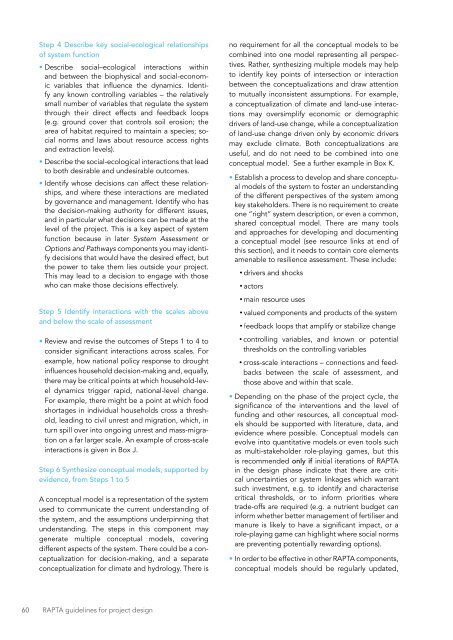DESIGNING PROJECTS IN A RAPIDLY CHANGING WORLD
srun3013fp1
srun3013fp1
Create successful ePaper yourself
Turn your PDF publications into a flip-book with our unique Google optimized e-Paper software.
Step 4 Describe key social-ecological relationships<br />
of system function<br />
• Describe social–ecological interactions within<br />
and between the biophysical and social-economic<br />
variables that influence the dynamics. Identify<br />
any known controlling variables – the relatively<br />
small number of variables that regulate the system<br />
through their direct effects and feedback loops<br />
(e.g. ground cover that controls soil erosion; the<br />
area of habitat required to maintain a species; social<br />
norms and laws about resource access rights<br />
and extraction levels).<br />
• Describe the social-ecological interactions that lead<br />
to both desirable and undesirable outcomes.<br />
• Identify whose decisions can affect these relationships,<br />
and where these interactions are mediated<br />
by governance and management. Identify who has<br />
the decision-making authority for different issues,<br />
and in particular what decisions can be made at the<br />
level of the project. This is a key aspect of system<br />
function because in later System Assessment or<br />
Options and Pathways components you may identify<br />
decisions that would have the desired effect, but<br />
the power to take them lies outside your project.<br />
This may lead to a decision to engage with those<br />
who can make those decisions effectively.<br />
no requirement for all the conceptual models to be<br />
combined into one model representing all perspectives.<br />
Rather, synthesizing multiple models may help<br />
to identify key points of intersection or interaction<br />
between the conceptualizations and draw attention<br />
to mutually inconsistent assumptions. For example,<br />
a conceptualization of climate and land-use interactions<br />
may oversimplify economic or demographic<br />
drivers of land-use change, while a conceptualization<br />
of land-use change driven only by economic drivers<br />
may exclude climate. Both conceptualizations are<br />
useful, and do not need to be combined into one<br />
conceptual model. See a further example in Box K.<br />
• Establish a process to develop and share conceptual<br />
models of the system to foster an understanding<br />
of the different perspectives of the system among<br />
key stakeholders. There is no requirement to create<br />
one “right” system description, or even a common,<br />
shared conceptual model. There are many tools<br />
and approaches for developing and documenting<br />
a conceptual model (see resource links at end of<br />
this section), and it needs to contain core elements<br />
amenable to resilience assessment. These include:<br />
• drivers and shocks<br />
• actors<br />
• main resource uses<br />
Step 5 Identify interactions with the scales above<br />
and below the scale of assessment<br />
• Review and revise the outcomes of Steps 1 to 4 to<br />
consider significant interactions across scales. For<br />
example, how national policy response to drought<br />
influences household decision-making and, equally,<br />
there may be critical points at which household-level<br />
dynamics trigger rapid, national-level change.<br />
For example, there might be a point at which food<br />
shortages in individual households cross a threshold,<br />
leading to civil unrest and migration, which, in<br />
turn spill over into ongoing unrest and mass-migration<br />
on a far larger scale. An example of cross-scale<br />
interactions is given in Box J.<br />
Step 6 Synthesize conceptual models, supported by<br />
evidence, from Steps 1 to 5<br />
A conceptual model is a representation of the system<br />
used to communicate the current understanding of<br />
the system, and the assumptions underpinning that<br />
understanding. The steps in this component may<br />
generate multiple conceptual models, covering<br />
different aspects of the system. There could be a conceptualization<br />
for decision-making, and a separate<br />
conceptualization for climate and hydrology. There is<br />
• valued components and products of the system<br />
• feedback loops that amplify or stabilize change<br />
• controlling variables, and known or potential<br />
thresholds on the controlling variables<br />
• cross-scale interactions – connections and feedbacks<br />
between the scale of assessment, and<br />
those above and within that scale.<br />
• Depending on the phase of the project cycle, the<br />
significance of the interventions and the level of<br />
funding and other resources, all conceptual models<br />
should be supported with literature, data, and<br />
evidence where possible. Conceptual models can<br />
evolve into quantitative models or even tools such<br />
as multi-stakeholder role-playing games, but this<br />
is recommended only if initial iterations of RAPTA<br />
in the design phase indicate that there are critical<br />
uncertainties or system linkages which warrant<br />
such investment, e.g. to identify and characterise<br />
critical thresholds, or to inform priorities where<br />
trade-offs are required (e.g. a nutrient budget can<br />
inform whether better management of fertiliser and<br />
manure is likely to have a significant impact, or a<br />
role-playing game can highlight where social norms<br />
are preventing potentially rewarding options).<br />
• In order to be effective in other RAPTA components,<br />
conceptual models should be regularly updated,<br />
60 RAPTA guidelines for project design


